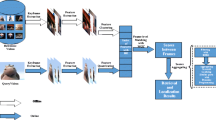Abstract
Facing the explosive growth of near-duplicate videos, video archaeology is quite desired to investigate the history of the manipulations on these videos. With the determination of derived videos according to the manipulations, a video migration map can be constructed with the pair-wise relationships in a set of near-duplicate videos. In this paper, we propose an improved video archaeology (I-VA) system by extending our previous work (Shen et al. 2010). The extensions include more comprehensive video manipulation detectors and improved techniques for these detectors. Specially, the detectors are used for two categories of manipulations, i.e., semantic-based manipulations and non-semantic-based manipulations. Moreover, the improved detecting algorithms are more stable. The key of I-VA is the construction of a video migration map, which represents the history of how near-duplicate videos have been manipulated. There are various applications based on the proposed I-VA system, such as better understanding of the meaning and context conveyed by the manipulated videos, improving current video search engines by better presentation based on the migration map, and better indexing scheme based on the annotation propagation. The system is tested on a collection of 12,790 videos and 3,481 duplicates. The experimental results show that I-VA can discover the manipulation relation among the near-duplicate videos effectively.














Similar content being viewed by others
References
Aradilla G, Vepa J, Bourlard H (2006) Using posterior-based features in template matching for speech recognition. In: Proc. of the international conference on spoken language processing. Pittsburgh, USA, pp 2570–2573
Boreczky JS, Rowe LA (1996) Comparison of video shot boundary detection techniques. In: Proc. of storage and retrieval for still image and video databases, pp 170–179
Cheung SC, Zakhor A (2003) Efficient video similarity measurement with video signature. IEEE Trans Circuits Syst Video Technol 13(1):59–74
Cheung SC, Zakhor A (2005) Fast similarity search and clustering of video sequences on world-wide-web. IEEE Trans Circuits Syst Video Technol 7(3):524–537
Google video. Available: http://video.google.com. Accessed Oct 2011
Hampapur A, Bolle R (2002) Comparison of sequence matching techniques for video copy detection, pp 194–201
Kashino K, Kurozumi T, Murase H (2003) A quick search method for audio and video signals based on histogram pruning. IEEE Trans Multimedia 5(3):348–357
Kennedy L, Chang S-F (2008) Internet image archaeology: automatically tracing the manipulation history of photographs on the web. In: Proc. of the 16th ACM international conference on multimedia, pp 349–358
Laptev I, Lindeberg T (2002) Space-time interest points, pp 128–142
Lowe D (2003) Distinctive image features from scale-invariant keypoints. Int J Comput Vis 20:91–110
Marziliano P, Dufaux F, Winkler S, Ebrahimi T (2002) A no-reference perceptual blur metric. In: Proc. of the international conference on image processing, vol 3, pp 57–60
Meinedo H, Neto J (2003) Audio segmentation, classification and clustering in a broadcast news task. In: Proc. of the international conference on acoustics, speech, and signal processing, vol 2, pp 5–8
Mikolajczyk K, Schmid C (2002) An affine invariant interest point detector. Copenhagen, Denmark, pp 128–142
Mikolajczyk K, Schmid C (2003) An performance evaluation of local descriptors. In: Proc. of IEEE international conference on computer vision and pattern recognition, pp 257–264
Paisitkriangkrai S, Mei T, Zhang J, Hua X-S (2010) Scalable clip-based near-duplicate video detection with ordinal measure. In: Proc. of ACM international conference on image and video retrieval. Xi’an, China, pp 121–128
Sakoe H, Chiba S (1971) Recognition of continuously spoken words based on time normalization by dynamic programming. J Acoust Soc Japan 27(9):483–500
Sakoe H, Chiba S (1978) Dynamic programming algorithm optimization for spoken word recognition. IEEE Trans on Acoustics, Speech, and Signal Processing 26:43–49
Shen J, Mei T, Gao X (2010) Automatic video archaeology: tracing your online videos. In: Workshop of social media, in conjunction of ACM MM, pp 59–64
Silverman H, Morgan DP (1982) The application of dynamic programming to cconnected speech recognition. In: Proc. of international conference on acoustics, speech, and signal processing, pp 1649–1652
Videosurf’s new release. available: http://www.videosurf.com/blog/videosurfs-new-release-1075/. Accessed Oct 2011
Wang Z, Sheikh HR, Bovik AC (2002) No-reference pperceptual qquality assessment of jpeg ccompressed images. In: Proc. of IEEE international conference on image processing, vol 20, pp 477–480
Wu X, Hauptmann AG, Ngo CW (2007) Practical elimination of near-duplicates from web video search. In: Proc. of the 15th international conference on multimedia, pp 218–227
Yahoo! video. Available: http://video.yahoo.com/. Accessed Oct 2011
Youtube. Available: http://www.youtube.com/. Accessed Oct 2011
Youssef AM, Abdel-Galil TK, El-Saadany EF, Salama MMA (2004) Disturbance classification utilizing dynamic time warping classifier. IEEE Trans Power Deliv 19(1):272–278
Yuan J, Duan L, Tian Q, Xu C (2004) Fast and robust short video clip search using an index structure, pp 61–68
Zhang H-J, Kankanhalli A, Smoliar SW (1993) Automatic partitioning of full-motion video. Multimedia Syst 1(1):10–28
Zhao W, Ngo CW, Tan H, Wu X (2007) Near-duplicate keyframe identification with interest point matching and pattern learning. IEEE Trans Multimedia 9(5):1037–1048
Zhou X, Zhou X, Chen L (2009) An efficient near-duplicate video shot detection method using shot-based interest points. IEEE Trans Multimedia 11(5):879–891
Acknowledgements
We want to thank the helpful comments and suggestions from the anonymous reviewers. This research was supported partially by the National Natural Science Foundation of China under Grants 61125204, 61172146, 60832005 and 41031064, the Ph.D. Programs Foundation of Ministry of Education of China under Grant 20090203110002, and the Research Projector Funding of Microsoft Research Asia.
Author information
Authors and Affiliations
Corresponding author
Rights and permissions
About this article
Cite this article
Shen, J., Mei, T. & Gao, X. Video archaeology: understanding video manipulation history. Multimed Tools Appl 63, 461–483 (2013). https://doi.org/10.1007/s11042-011-0922-y
Published:
Issue Date:
DOI: https://doi.org/10.1007/s11042-011-0922-y




